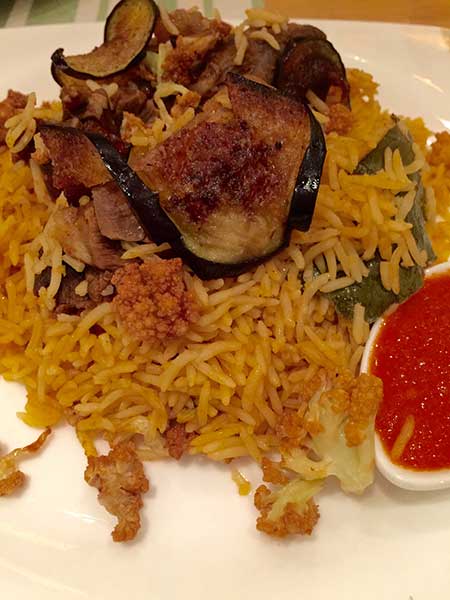Lebanon revisited
 |
|
Maglooba rice combines Mediterranean spices with pilaf-style rice and lamb.[Photo by Mike Peters/China Daily] |
Emerging from renovation, a Middle Eastern eatery reopens in Sanlitun with a well-remembered menu and a few new additions, including a famous wine from the Bekaa Valley. Mike Peters reports.
When I first came to Beijing in 2009, one of my most welcome discoveries was Alameen. As I passed by on the sidewalk, two Lebanese men toted an immense foil-wrapped package, gently steaming and fragrant with oregano, garlic and roasted lamb.
I was inside in a heartbeat.
Packed with Arabic speakers in a corner of expat haven Sanlitun, I found that Ala-meen served up delicious food at a moderate price. In Arabic, the name means "honest".
So when I saw jackhammers and plasterers swarming the place earlier this fall, I was nervously anticipating a pretty-up and the pricy-up that usually follows.
I needn't have worried. Recently reopened, the rehabbed space is bright and airy, and the prices continue to be affordable-though most have crept up 5 or 10 yuan, says co-owner Ling Hongfang. A small plate of four appetizers runs 40 yuan ($6.30), and includes generous dollops of familiar hummus, a chick-pea paste with a flourish of parsley, and baba ghanoush, made with eggplant and minced peppers. More exotic is lebaneh, made from sugar-free yoghurt and tasting (to me) vaguely like cottage cheese. We get a plate of hot, puffy Arab bread on the side.
It's a platter that would have been recognized by ancient traders of the Levant, where modern Lebanon and Israel are perched on the eastern shore of the Mediterranean Sea. They would mix the local herb Za'atar, an oregano species, with sumac, sesame or pine nuts and a litany of other choices, writes author Laura Kelley on her blog, The Silk Road Gourmet. "This would have been mixed in olive oil and used to flavor bread as a dip. Plates of herbs, like dill or fennel, might have also offered flavor to the bread and would have been served as fresh as possible."
















